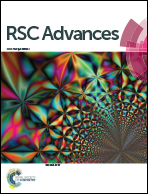Plate-like LiFePO4 crystallite with preferential growth of (010) lattice plane for high performance Li-ion batteries
Abstract
Plate-like LiFePO4 nanocrystallites with preferential growth of the (010) lattice plane are successfully prepared by a low temperature synthesis using a binary mixed solvent system of water and ethylene glycol (EG). A series of analyses, such as X-ray diffraction (XRD), scanning electron microscopy (SEM), high-resolution transmission electron microscopy (HRTEM) and selected area electron diffraction (SAED) were performed to characterize the structure and morphology of the as-obtained products. Compared with conventional LiFePO4 nanoparticles, the LiFePO4 nanoplates possess an enlarged (010) surface to volume ratio besides a reduced Li-ion transport length. Such preferential growth of the (010) lattice plane can strongly facilitate Li-diffusion and endow LiFePO4 with an excellent high rate performance as a Li-ion battery (LIB) cathode material. The LiFePO4 nanoplates exhibit a high Li-ion diffusion coefficient of 1.28 × 10−12 cm2 s−1 compared to that of LiFePO4 nanoparticles (i.e., 3.37 × 10−13 cm2 s−1). The as-obtained LiFePO4 nanoplates deliver great capacities of 113.4 mA h g−1 and 85.6 mA h g−1 even at 10 C and 20 C respectively. In addition, micro-nano-structured morphology control provides an additional strategy to obtain excellent LiFePO4 cathode materials with an excellent high rate performance and cycling stability.


 Please wait while we load your content...
Please wait while we load your content...